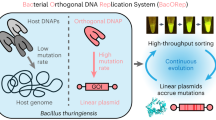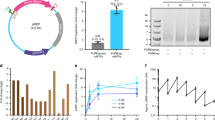Abstract
Most existing directed evolution methods, both in vivo1,2,3 and in vitro4,5,6, suffer from inadvertent selective pressures (i.e., altering organism fitness), resulting in the evolution of products with unintended or suboptimal function. To overcome these barriers, here we present compartmentalized partnered replication (CPR). In this approach, synthetic circuits are linked to the production of Taq DNA polymerase so that evolved circuits that most efficiently drive Taq DNA polymerase production are enriched by exponential amplification during a subsequent emulsion PCR step. We apply CPR to evolve a T7 RNA polymerase variant that recognizes an orthogonal promoter and to reengineer the tryptophanyl tRNA-synthetase:suppressor tRNA pair from Saccharomyces cerevisiae7 to efficiently and site-specifically incorporate an unnatural amino acid into proteins. In both cases, the CPR-evolved parts were more orthogonal and/or more active than variants evolved using other methods. CPR should be useful for evolving any genetic part or circuit that can be linked to Taq DNA polymerase expression.
This is a preview of subscription content, access via your institution
Access options
Subscribe to this journal
Receive 12 print issues and online access
$209.00 per year
only $17.42 per issue
Buy this article
- Purchase on Springer Link
- Instant access to full article PDF
Prices may be subject to local taxes which are calculated during checkout



Similar content being viewed by others
References
Collins, C.H., Leadbetter, J.R. & Arnold, F.H. Dual selection enhances the signaling specificity of a variant of the quorum-sensing transcriptional activator LuxR. Nat. Biotechnol. 24, 708–712 (2006).
Sinha, J., Reyes, S.J. & Gallivan, J.P. Reprogramming bacteria to seek and destroy an herbicide. Nat. Chem. Biol. 6, 464–470 (2010).
Esvelt, K.M., Carlson, J.C. & Liu, D.R. A system for the continuous directed evolution of biomolecules. Nature 472, 499–503 (2011).
Ellington, A.D. & Szostak, J.W. In vitro selection of RNA molecules that bind specific ligands. Nature 346, 818–822 (1990).
Tawfik, D.S. & Griffiths, A.D. Man-made cell-like compartments for molecular evolution. Nat. Biotechnol. 16, 652–656 (1998).
Levy, M., Griswold, K.E. & Ellington, A.D. Direct selection of trans-acting ligase ribozymes by in vitro compartmentalization. RNA 11, 1555–1562 (2005).
Hughes, R.A. & Ellington, A.D. Rational design of an orthogonal tryptophanyl nonsense suppressor tRNA. Nucleic Acids Res. 38, 6813–6830 (2010).
Hughes, R.A., Miklos, A.E. & Ellington, A.D. Gene synthesis: methods and applications. Methods Enzymol. 498, 277–309 (2011).
Gibson, D.G. Enzymatic assembly of overlapping DNA fragments. Methods Enzymol. 498, 349–361 (2011).
Temme, K., Zhao, D. & Voigt, C.A. Refactoring the nitrogen fixation gene cluster from Klebsiella oxytoca. Proc. Natl. Acad. Sci. USA 109, 7085–7090 (2012).
Tan, C., Marguet, P. & You, L. Emergent bistability by a growth-modulating positive feedback circuit. Nat. Chem. Biol. 5, 842–848 (2009).
Wang, H.H. et al. Programming cells by multiplex genome engineering and accelerated evolution. Nature 460, 894–898 (2009).
Ghadessy, F.J., Ong, J.L. & Holliger, P. Directed evolution of polymerase function by compartmentalized self-replication. Proc. Natl. Acad. Sci. USA 98, 4552–4557 (2001).
Ghadessy, F.J. & Holliger, P. Compartmentalized self-replication: a novel method for the directed evolution of polymerases and other enzymes. Methods Mol. Biol. 352, 237–248 (2007).
Cheetham, G.M., Jeruzalmi, D. & Steitz, T.A. Structural basis for initiation of transcription from an RNA polymerase-promoter complex. Nature 399, 80–83 (1999).
Raskin, C.A., Diaz, G.A. & McAllister, W.T. T7 RNA polymerase mutants with altered promoter specificities. Proc. Natl. Acad. Sci. USA 90, 3147–3151 (1993).
Chelliserrykattil, J., Cai, G. & Ellington, A.D. A combined in vitro/in vivo selection for polymerases with novel promoter specificities. BMC Biotechnol. 1, 13 (2001).
Temme, K., Hill, R., Segall-Shapiro, T.H., Moser, F. & Voigt, C.A. Modular control of multiple pathways using engineered orthogonal T7 polymerases. Nucleic Acids Res. 40, 8773–8781 (2012).
Zhou, M., Dong, X., Shen, N., Zhong, C. & Ding, J. Crystal structures of Saccharomyces cerevisiae tryptophanyl-tRNA synthetase: new insights into the mechanism of tryptophan activation and implications for anti-fungal drug design. Nucleic Acids Res. 38, 3399–3413 (2010).
Shaw, J.B. et al. Complete protein characterization using top-down mass spectrometry and ultraviolet photodissociation. J. Am. Chem. Soc. 135, 12646–12651 (2013).
Young, T.S., Ahmad, I., Yin, J.A. & Schultz, P.G. An enhanced system for unnatural amino acid mutagenesis in E. coli. J. Mol. Biol. 395, 361–374 (2010).
Johnson, D.B.F. et al. RF1 knockout allows ribosomal incorporation of unnatural amino acids at multiple sites. Nat. Chem. Biol. 7, 779–786 (2011).
Breaker, R.R. & Joyce, G.F. Emergence of a replicating species from an in vitro RNA evolution reaction. Proc. Natl. Acad. Sci. USA 91, 6093–6097 (1994).
Bull, J.J. & Pease, C.M. Why is the polymerase chain reaction resistant to in vitro evolution? J. Mol. Evol. 41, 1160–1164 (1995).
Goldsmith, M. & Tawfik, D.S. Potential role of phenotypic mutations in the evolution of protein expression and stability. Proc. Natl. Acad. Sci. USA 106, 6197–6202 (2009).
Dickinson, B.C., Leconte, A.M., Allen, B., Esvelt, K.M. & Liu, D.R. Experimental interrogation of the path dependence and stochasticity of protein evolution using phage-assisted continuous evolution. Proc. Natl. Acad. Sci. USA 110, 9007–9012 (2013).
Paige, J.S., Wu, K.Y. & Jaffrey, S.R. RNA mimics of green fluorescent protein. Science 333, 642–646 (2011).
Davidson, E.A., Meyer, A.J., Ellefson, J.W., Levy, M. & Ellington, A.D. An in vitro Autogene. ACS Synth. Biol. 1, 190–196 (2012).
Fromant, M., Blanquet, S. & Plateau, P. Direct random mutagenesis of gene-sized DNA fragments using polymerase chain reaction. Anal. Biochem. 224, 347–353 (1995).
Cormack, B.P., Valdivia, R.H. & Falkow, S. FACS-optimized mutants of the green fluorescent protein (GFP). Gene 173, 33–38 (1996).
Kast, P. & Hennecke, H. Amino acid substrate specificity of Escherichia coli phenylalanyl-tRNA synthetase altered by distinct mutations. J. Mol. Biol. 222, 99–124 (1991).
Thyer, R., Filipovska, A. & Rackham, O. Engineered rRNA enhances the efficiency of selenocysteine incorporation during translation. J. Am. Chem. Soc. 135, 2–5 (2013).
Wang, L., Brock, A., Herberich, B. & Schultz, P.G. Expanding the genetic code of Escherichia coli. Science 292, 498–500 (2001).
Han, S.-W. et al. Tyrosine sulfation in a Gram-negative bacterium. Nat. Commun. 3, 1153 (2012).
Chatterjee, A., Xiao, H., Yang, P.-Y., Soundararajan, G. & Schultz, P.G.A. Tryptophanyl-tRNA synthetase/tRNA pair for unnatural amino acid mutagenesis in E. coli. Angew Chem. Int. Ed. Engl. 52, 5106–5109 (2013).
Acknowledgements
This work was supported by the National Security Science and Engineering Faculty (FA9550–10-1-0169) the Welch Foundation (F–1654 to A.D.E. and F-1155 to J.S.B.), the National Science Foundation (CHE1012622 to J.S.B.), and the Defense Advanced Research Projects Agency (HR–0011-12-C-0066). J.S.B. thanks Thermo Fisher Scientific with helping on the modifications to the Orbitrap Elite mass spectrometer to allow UVPD.
Author information
Authors and Affiliations
Contributions
J.W.E. conceived of the selection scheme. A.J.M. carried out experiments with T7 RNA polymerase. J.W.E. carried out experiments on the ScWRS and tRNA with input from R.A.H. J.R.C. and J.S.B. performed mass spectrometry and analysis. J.W.E., A.J.M. and A.D.E. wrote the manuscript with contributions from R.A.H., J.R.C. and J.S.B.
Corresponding author
Ethics declarations
Competing interests
The authors declare no competing financial interests.
Supplementary information
Supplementary Text and Figures
Supplementary Figures 1–21 and Supplementary Tables 1–4 (PDF 3840 kb)
Rights and permissions
About this article
Cite this article
Ellefson, J., Meyer, A., Hughes, R. et al. Directed evolution of genetic parts and circuits by compartmentalized partnered replication. Nat Biotechnol 32, 97–101 (2014). https://doi.org/10.1038/nbt.2714
Received:
Accepted:
Published:
Issue Date:
DOI: https://doi.org/10.1038/nbt.2714
This article is cited by
-
Virus-assisted directed evolution of enhanced suppressor tRNAs in mammalian cells
Nature Methods (2023)
-
Cell-free Biosynthesis of Peptidomimetics
Biotechnology and Bioprocess Engineering (2023)
-
A frame-shifted gene, which rescued its function by non-natural start codons and its application in constructing synthetic gene circuits
Journal of Biological Engineering (2019)
-
Expanding the limits of the second genetic code with ribozymes
Nature Communications (2019)
-
Escherichia coli “Marionette” strains with 12 highly optimized small-molecule sensors
Nature Chemical Biology (2019)



